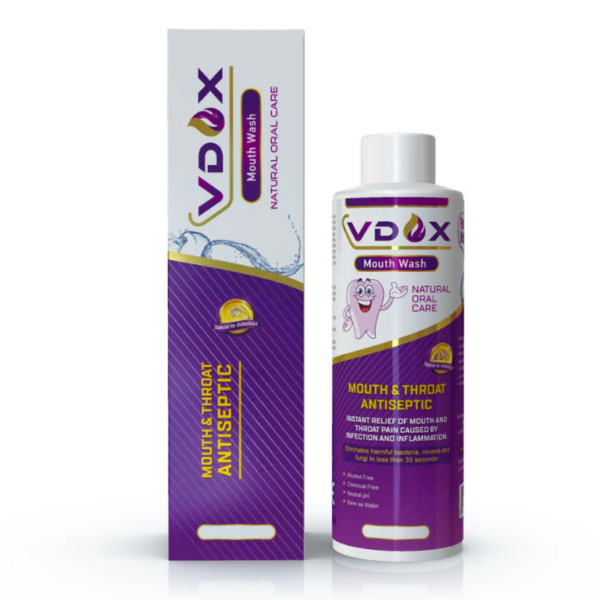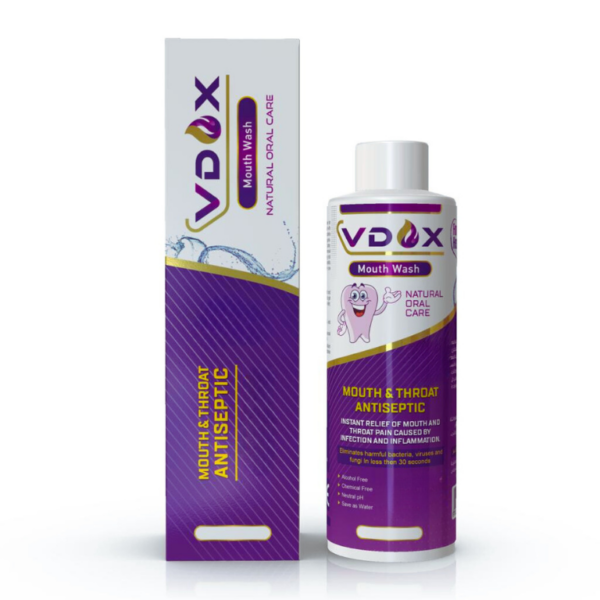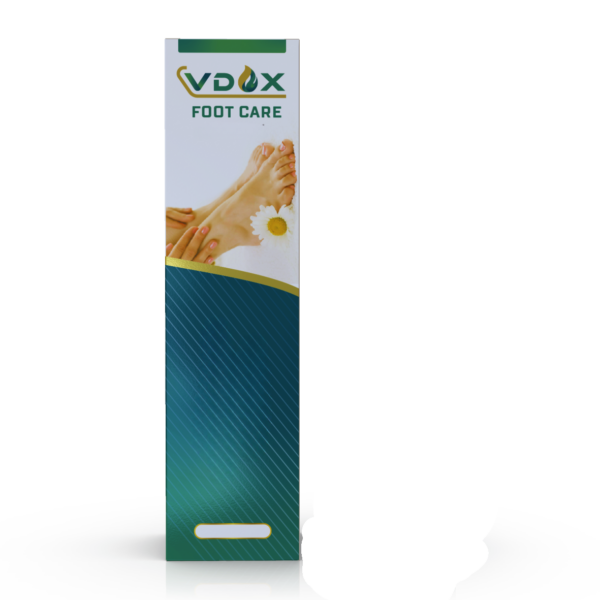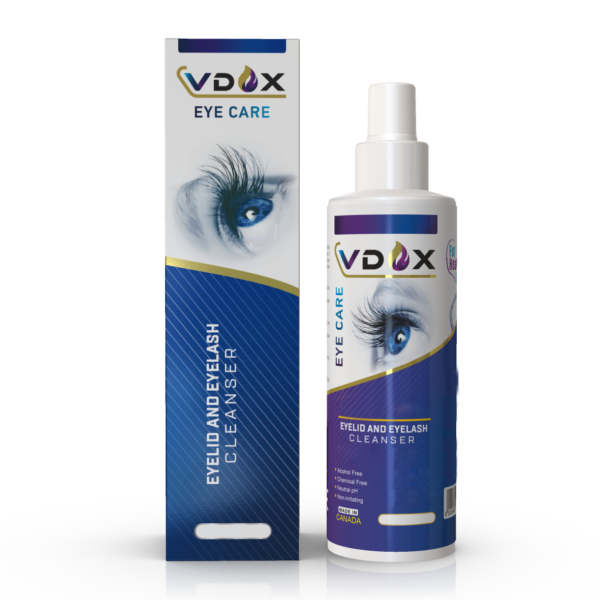
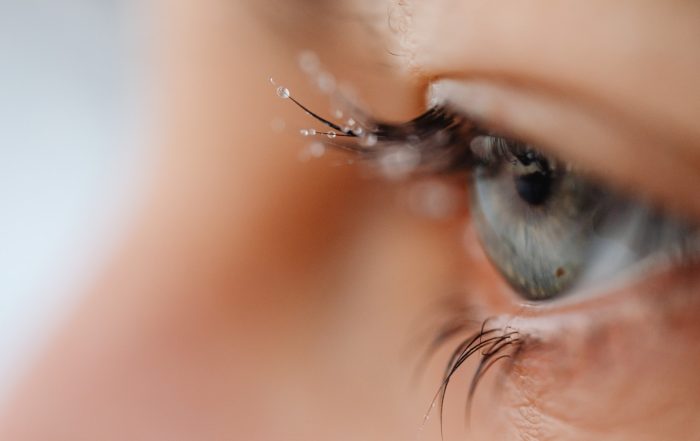
VDOX® is an antimicrobial prescription hypochlorous acid (HOCl) based eyelid and eyelash cleanser that is scientifically proven to eradicate the microorganisms that cause discomfort, FAST enough to provide near instant RELIEF, and SÛRE and GENTLE enough to use as often as needed for all ages and skin types.
If you’re like most people, you probably use your eyes as your primary means of communication. And, like most things, your eyes need some TLC to stay healthy and look their best. When you suffer from chronic illnesses that cause vision problems, it can have a negative impact on you. Maybe you sleep with a washcloth next to your bed, or you can’t see your clock in the morning without first rinsing your eyes. That’s where VDOX® Performance Stabilized HOCl Antimicrobial Eyelid & Eyelash Hygiene comes in.
Hypochlorous acid is a natural, gentle, and non-toxic compound that is naturally produced by white blood cells in the human body. Its primary function is to aid in the fight against infections by killing viruses, bacteria, fungi, yeast, and even some parasites. Because hypochlorous acid has strong antimicrobial properties, it is ideal for cleansing, disinfecting, and protecting the eyes and eyelids. It works by breaking down the cell membranes of bacteria and other microorganisms, preventing them from reproducing and causing infections. It is incredibly gentle on the skin yet powerful enough to kill germs, reduce inflammation, and promote healing.
The health benefits of hypochlorous acid extend far beyond its antimicrobial properties. It’s an anti-inflammatory agent, a potent antioxidant, stable, has a broad spectrum of efficacy, and is safe to use regularly. It has been studied for its ability to reduce the appearance of wrinkles and age spots and for its potential to help heal wounds and other skin damage.
Hypochlorous acid has also been found to be very effective in cleaning the eyelids and eyelashes. It helps to remove debris and microorganisms from the eyelids and eyelashes, as well as provide relief from itching and irritation. It also helps to reduce inflammation, redness, and swelling, while providing an extra layer of protection from bacteria and other microorganisms.
VDOX® Performance Stabilized hypochlorous acid is a safe and effective treatment for a wide range of eye-related conditions, including Blepharitis, Meibomian Gland Dysfunction, Dry Eye, Contact Lens Intolerance, and other inflammations of the outer eye caused by allergies, and its antimicrobial properties make it beneficial for pre and post surgical eye procedures.
Blepharitis is a common and irritating eye condition that affects millions of people worldwide. It’s an inflammation of the eyelids that can cause redness, swelling, and crusting of the lids. If you’ve ever experienced it, you know how uncomfortable it can be. VDOX® is a safe and natural way to help relieve the symptoms of blepharitis. It works by killing the bacteria that cause blepharitis, reducing inflammation, and helping to restore the natural balance and health of the eyelids.
Meibomian Gland Dysfunction (MGD) is a common and often painful condition that affects the health of your eyes. This is a chronic condition caused by abnormalities with the Meibomian glands, which are located in the eyelids and produce oils that help keep the eyes lubricated. MGD causes dry eye symptoms including redness, irritation, and pain. VDOX® reduces inflammation, itch, and helps the balance of moisture in the eyes by breaking down the lipid based biofilm that clogs the meibomian glands.
Dry Eye is a common condition that causes eye pain, redness, and dryness. VDOX® works by cleaning the surface of the eye, removing any foreign particles that can contribute to the inflammation associated with dry eyes. In addition, VDOX® helps to restore the natural tear film that coats the surface of the eye, helping to reduce the dryness and irritation, as well as provide relief from pain and inflammation.
Contact Lens Intolerance can cause redness, irritation, and pain when wearing contact lenses. VDOX® has been found to be extremely effective for relieving symptoms of contact lens intolerance. Studies have shown it to be more effective than some of the traditional treatments for this issue. In one study, 90% of people who used HOCl reported reduced contact lens discomfort and 75% reported improved comfort when wearing lenses.
Pre- and post-surgical eye procedures can benefit from VDOX® due to its antimicrobial properties. It has been shown to effectively eradicate a wide variety of microorganisms, which can help reduce the risk of infection during and after surgery.
Additionally, HOCl has a neutral pH level, which makes it gentle on delicate tissues such as the eyes. This can help prevent irritation or other adverse reactions that may occur with other disinfectants that have a higher pH level. HOCl can also be used to irrigate the eye or as a topical solution on the eyelids and surrounding areas to disinfect the surgical site, and as a postoperative topical solution to help promote healing and reduce the risk of infection.
For these reasons, it is no surprise that VDOX® is quickly becoming the go-to choice for many when it comes to eyelid and eyelash care and treatment. It is gentle enough to be used by all ages and skin types, yet powerful enough to be used to treat a wide range of skin issues.
VDOX® Antimicrobial Eyelid & Eyelash Hygiene is designed to help you cleanse, relieve, and restore your skin by removing encrustation and debris to help manage red, itchy, crusty, inflamed eyes, providing FAST relief!
Try VDOX® Antimicrobial Eyelid & Eyelash Hygiene today and see the difference for yourself. You’ll be glad you did!
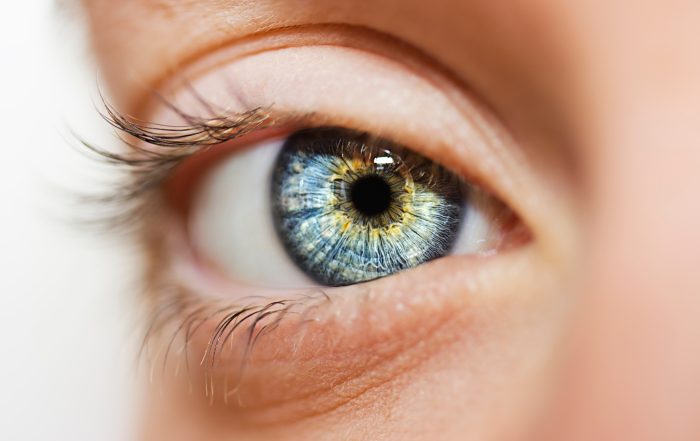
The Meibomian gland is a type of sebaceous gland located in the eyelid near the eyelashes. Its function is to secrete an oily substance called meibum, which helps to lubricate the surface of the eye and prevent the evaporation of tears. The meibum produced by these glands also helps to protect the eye from bacterial infections and other irritants.
Sebaceous glands are small glands located in the skin that secrete an oily substance called sebum. These glands are found all over the body, but are most concentrated on the face, scalp, chest, and back. Sebum helps to lubricate and waterproof the skin and hair, and also has antimicrobial properties that help to protect the skin from infection. Sebaceous glands are also involved in the development of acne, as overproduction of sebum can clog hair follicles and lead to the formation of pimples and other blemishes.
Sebum is an oily substance that is produced by the sebaceous glands in the skin. These glands are found all over the body, but are most concentrated on the face, scalp, chest, and back. Sebum is composed of a mixture of lipids, including triglycerides, wax esters, squalene, and cholesterol esters.
The primary function of sebum is to lubricate and waterproof the skin and hair. Sebum helps to keep the skin supple and hydrated, and also has antimicrobial properties that help to protect against infection. However, overproduction of sebum can also lead to the development of acne, a common skin condition characterized by the formation of pimples, blackheads, and other blemishes.
Meibum is a complex mixture of lipids that is secreted by the Meibomian glands in the eyelids. These glands are specialized sebaceous glands that produce a thick, oily substance that is used to lubricate and protect the surface of the eye. Meibum is composed of a variety of lipids, including wax esters, cholesterol esters, triglycerides, phospholipids, and free fatty acids.
The composition of meibum is critical to its function in maintaining the stability of the tear film. The tear film is a thin layer of fluid that covers the surface of the eye and helps to protect it from damage, infection, and dryness. Meibum helps to prevent the evaporation of tears and maintain the integrity of the tear film, which is essential for clear vision and eye health.
Dysfunction of the Meibomian gland can lead to a condition known as Meibomian gland dysfunction (MGD), which can lead to a decrease in the quality and quantity of meibum. MGD is a common cause of dry eye syndrome, a condition in which the eyes become dry, itchy, and irritated due to a lack of sufficient tear production or poor tear quality. Symptoms of MGD can include dryness, redness, itching, and irritation of the eyes. Patients may also experience a gritty sensation in the eyes, as well as blurred vision, sensitivity to light, and eye fatigue. These symptoms can be severe enough to interfere with daily activities, such as reading or using a computer.
There are several factors that can contribute to the development of MGD, including hormonal changes, aging, and environmental factors. Other risk factors for MGD include the use of contact lenses, certain medications, and pre-existing medical conditions such as rosacea and autoimmune disorders.
The key to preventing MGD is maintaining good eyelid hygiene. VDOX® Antimicrobial Eyelid & Eyelash Hygiene is a Performance Stabilized HOCl that eradicates microorganisms, breaks down lipids, and removes encrustation and debris to help manage red, inflamed, itchy eyes. VDOX® is safe for use on all skin types and at any age. It is non-toxic, non-irritating, non-sensitizing, steroid-free, antibiotic-free, and alcohol-free. Use it twice daily as needed or recommended.
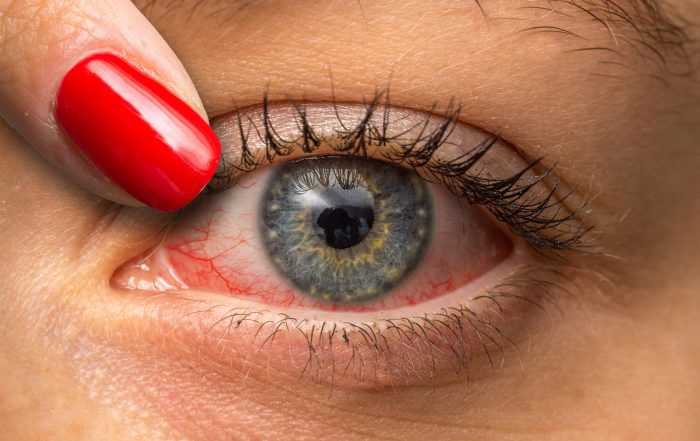
Dry eyes can be an uncomfortable condition for many, causing a range of symptoms including redness, itchiness, fatigue, and blurry vision. It is important to understand the causes of dry eyes in order to properly address this condition. In this blog, we will explore the various factors that can lead to dry eyes, including aging, hormonal changes, environmental conditions, prolonged use of digital devices, and certain medical conditions or medications. Read on to learn more about how to identify the cause of dry eyes and what you can do to find relief.
AGING
Aging can cause dry eyes due to a decrease in tear production and quality. As we age, our tear glands produce fewer tears, and the composition of the tears may also change, leading to an increase in evaporation and a decrease in the lubricating properties of the tears. Dry eye symptoms can also be caused by health problems that are common in older people, such as arthritis or diabetes.
HORMONAL CHANGES
Hormonal changes, particularly in women, can cause dry eyes. Changes in hormone levels, such as those that occur during menopause or pregnancy, can affect the composition of the tears and decrease tear production. Menopause can lead to a decrease in hormone production, including estrogen, which can affect the meibomian glands in the eyelids that secrete oil onto the surface of the eye to prevent tear evaporation. This can lead to evaporative dry eye. Additionally, fluctuations in hormone levels during the menstrual cycle can also cause temporary changes in tear production and quality, leading to dry eye symptoms.
ENVIRONMENTAL CONDITIONS
Environmental conditions that can lead to dry eyes include exposure to dry, windy or dusty conditions, high altitude, air conditioning or heating, and exposure to cigarette smoke or other pollutants. These conditions can cause the tears to evaporate more quickly and lead to symptoms of dryness, irritation, and discomfort. Additionally, exposure to low humidity conditions, such as those found on airplanes, can also contribute to dry eye symptoms.
DIGITAL DEVICES
Prolonged use of digital devices such as computers, smartphones, and tablets, can cause dry eyes in several ways. When we use electronic devices, we tend to blink less frequently, which can lead to a decrease in tear production and an increase in tear evaporation. In addition, the blue light emitted by these devices can also cause eye strain and fatigue, which can exacerbate dry eye symptoms. Studies have shown that people who spend extended periods of time using digital devices are more likely to experience dry eye symptoms than those who do not.
MEDICAL CONDITIONS & MEDICATIONS
Medical conditions that can cause dry eyes include autoimmune disorders such as Sjogren’s syndrome, which affects the body’s ability to produce moisture, and rheumatoid arthritis, a chronic inflammatory disorder. Other conditions that can contribute to dry eye symptoms include diabetes, thyroid disorders, rosacea, and allergies. Additionally, certain medications such as antihistamines, antidepressants, and blood pressure medications can also cause or worsen dry eye symptoms.
HYPOCHLOROUS ACID
HOCl, or Hypochlorous Acid, can potentially help treat and prevent dry eye by acting as a natural, gentle, and effective antimicrobial that can reduce the risk of eye infections and inflammation that can worsen dry eye symptoms. HOCl is a substance that is naturally produced by the human body’s immune system and has been found to have antimicrobial and anti-inflammatory properties.
VDOX®
VDOX® is an antimicrobial prescription or physician dispensed hypochlorous acid (HOCl) based eyelid and eyelash cleanser that is scientifically proven to eradicate the microorganisms that cause discomfort.
As a result, VDOX® Antimicrobial Eyelid & Eyelash Hygiene with Performance Stabilized HOCl helps reduce microbial load and inflammation of the eye, promoting healing and improving eye comfort and vision. HOCl, the active ingredient in VDOX®, has been shown to have several potential benefits for ocular health, one of which is the stabilization of the tear film. A study published by S. Koh, C.I. Tung, and J.V. Aquavella (2012) in the Journal of Ocular Pharmacology and Therapeutics evaluated the effect of HOCl eye drops on the tear film in patients with mild to moderate dry eye disease. The study found that HOCl eye drops improved tear film stability by increasing its viscosity, enhancing its lubricating properties, and reducing tear evaporation rate. Fast enough to provide near instant relief, and gentle enough to use as often as needed for all ages and skin types, VDOX® provides fast, reliable, and safe relief for dry eyes.
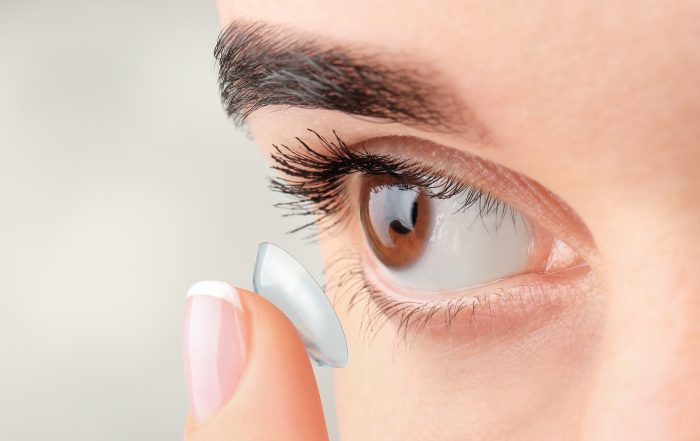
Contact lens intolerance can be relatively common, especially if the lenses are not properly fitted or if the individual has underlying eye conditions. It can also be influenced by personal factors such as eye dryness or sensitivity. However, with proper care and attention to individual needs, many people are able to successfully wear and enjoy contact lenses. Let’s take a deeper look!
Common Causes:
- Incorrect fit: If the lenses are not properly fitted, they can cause discomfort and irritation.
- Eye dryness: If the eyes are not producing enough tear fluid, this can cause discomfort and make it difficult to wear contact lenses.
- Eye infections: Infections such as conjunctivitis or blepharitis can cause inflammation and make the eyes more sensitive to contact lenses.
- Allergies: Allergies to the materials used in contact lenses, or to the cleaning solutions used to maintain them, can cause irritation and discomfort.
- Environmental factors: Exposure to dust, smoke, or air pollution can cause irritation and make it more difficult to wear contact lenses comfortably.
- Eyelid problems: Conditions such as meibomian gland dysfunction or eyelid inflammation can interfere with the normal lubrication of the eyes and cause discomfort when wearing contact lenses.
If you are experiencing discomfort or intolerance with your contact lenses, VDOX® Antimicrobial Eyelid & Eyelash Hygiene with Performance Stabilized HOCl may be the solution.
Incorrect Fit:
- Poorly fitting base curve: The base curve of the contact lens should match the curvature of your cornea for optimal comfort and vision. If the base curve is too steep or too flat, it can cause discomfort and irritation.
- Incorrect diameter: The diameter of the contact lens should be appropriate for your eye size. If the lens is too small or too large, it can cause discomfort and may not stay in place properly.
- Incorrect power or prescription: Contact lenses come in different powers or prescriptions to correct various vision problems. If the power or prescription is incorrect, it can lead to blurry vision and eye strain.
- Improper centering: The contact lens should be properly centered on your eye to ensure clear vision and comfort. If it is not centered properly, it can cause discomfort and vision problems.
- Incorrect material: Some individuals may be sensitive or allergic to certain materials used in contact lenses. If the wrong material is used, it can cause discomfort and may lead to eye infections.
It is important to have your contact lenses properly fitted by an eye care professional in order to ensure optimal comfort, vision and eye health.
Eye Dryness:
- Aging: As we age, the glands that produce tears may not function as well, leading to decreased tear production and dryness.
- Environmental factors: Air conditioning, heating, wind, smoke, dust, and dry air can all contribute to eye dryness.
- Medications: Certain medications can cause dry eyes as a side effect.
- Medical conditions: Autoimmune diseases such as Sjogren’s syndrome, rheumatoid arthritis, and lupus can cause dry eyes. Other conditions such as diabetes, thyroid disorders, and vitamin A deficiency can also contribute to dry eyes.
- Eye surgery: LASIK and other types of eye surgery can lead to temporary dryness due to nerve damage during the surgery.
If you experience persistent eye dryness, it is important to consult an eye doctor to diagnose and treat the underlying cause.
Eye Infections:
Conjunctivitis, also known as pink eye, is an inflammation or infection of the conjunctiva, which is the thin, transparent layer of tissue that lines the inside of the eyelid and covers the white part of the eye.
There are several different types of conjunctivitis, including:
- Viral conjunctivitis: This is caused by a viral infection and is highly contagious. It often starts in one eye and then spreads to the other.
- Bacterial conjunctivitis: This is caused by a bacterial infection and can be treated with antibiotics.
- Allergic conjunctivitis: This is caused by an allergic reaction, usually to pollen or other environmental allergens. It can occur seasonally or year-round.
- Chemical conjunctivitis: This is caused by exposure to irritants such as smoke or chemicals.
Symptoms of conjunctivitis include redness in one or both eyes, itchiness, a burning sensation, discharge or crustiness around the eyelid, and blurred or hazy vision. Treatment depends on the cause and may include antibiotic eye drops, antihistamines, or other medications to reduce inflammation. In some cases, home remedies such as warm compresses or artificial tears may be recommended.
Blepharitis is a common eye condition characterized by inflammation of the eyelids. It is a chronic condition that typically affects both eyes and is caused by bacteria or abnormalities in the oil glands at the base of the eyelashes.
There are two main types of blepharitis:
- Anterior blepharitis: This affects the outside front of the eyelid and is often caused by bacteria or dandruff from the scalp or eyebrows.
- Posterior blepharitis: This affects the inner eyelid and is typically caused by abnormalities in the oil glands, which can lead to the production of excess oil and the growth of bacteria.
Symptoms of blepharitis include redness, swelling, and itching of the eyelids, crusting or flaking of the skin around the eyelids, and a burning or gritty sensation in the eyes. In some cases, blepharitis may also lead to styes, chalazion, or problems with tear production.
Treatment for mild blepharitis typically involves a combination of self-care measures, such as warm compresses and cleaning of the eyelids to manage inflammation and control bacterial growth. In more severe cases, a doctor may also prescribe or dispense medications to treat underlying conditions that may be contributing to the development of blepharitis.
Allergies:
Reactions related to contact lens use can be due to allergies to the materials used in the contacts or the cleaning solutions used to maintain them.
Symptoms of contact lens allergies can include:
- Red, itchy, or watery eyes
- Sensitivity to light
- Swelling of the eyes or eyelids
- Discharge from the eyes
- Blurred vision
Some people may also experience an allergic reaction to the preservatives in certain contact lens solutions.
If you develop symptoms of an allergic reaction when using contact lenses, it is important to stop using the contacts and consult your eye doctor. They can help determine the cause of the allergic reaction and recommend alternatives, such as switching to a different type of contact lens material or cleaning solution.
Environmental Factors:
- Dust, smoke, and air pollution: Exposure to these irritants can cause dryness and irritation, making it difficult to wear contact lenses comfortably.
- High altitudes: High altitude can cause reduced oxygen levels, which can lead to eye dryness and discomfort when wearing contact lenses.
- Cold, dry air: Indoor heating or cold, dry air outside can reduce humidity levels and cause eye dryness.
- Windy conditions: Wind can also cause eye dryness and irritation, especially when wearing soft contact lenses.
- Water exposure: Exposure to water, such as during swimming or water sports, can increase the risk of eye infections and irritation.
If you experience discomfort or intolerance when wearing contact lenses in certain environments, it is important to speak with your eye doctor. They can recommend appropriate options, such as switching to a different type of lens or using artificial tears to alleviate symptoms. Additionally, it is important to follow proper lens care guidelines to reduce the risk of infection and improve comfort when wearing contact lenses.
Eyelid Problems:
Meibomian gland dysfunction (MGD) is a condition that affects the meibomian glands, which are the tiny oil glands located in the eyelids. These glands produce oil that keeps the surface of the eye lubricated and prevents tears from evaporating too quickly.
In MGD, the meibomian glands become blocked or damaged, which leads to an imbalance in the tear film and can cause dryness, irritation, and inflammation of the eyelids. MGD is a common condition and a major cause of dry eye syndrome.
Symptoms of MGD can include:
- Dry eyes
- Redness and swelling of the eyelids
- Discomfort when wearing contact lenses
- Blurred vision
- Eye irritation and a sensation of something in the eye
MGD can be treated with a combination of self-care measures and medical interventions, such as warm compresses to reduce inflammation and improve the quality of the oil produced by the meibomian glands. An eye doctor can help diagnose and recommend appropriate treatment for MGD based on the severity of the condition.
As discussed earlier, eyelid inflammation, also known as blepharitis, can be caused by several factors, including:
- Bacterial infections: Bacterial infections can cause inflammation of the eyelids and surrounding tissue.
- Allergies: Allergic reactions to pollen, dust or other environmental factors can cause eyelid inflammation.
- Skin conditions: Skin conditions such as eczema, psoriasis, or rosacea can affect the eyelids, leading to inflammation.
- Meibomian gland dysfunction: This is a dysfunction of the oil glands in the eyelids which can cause inflammation of the eyelids.
- Contact lenses: Use of certain contact lens solutions or wearing contact lenses for an extended period of time can contribute to eyelid inflammation.
- Makeup usage: Improper removal of eye makeup can lead to the accumulation of particles on the eyelids, triggering inflammation.
- Environmental factors: Exposure to environmental factors such as smoke, wind, sun, and air pollution can cause irritation and inflammation of the eyelids.
A Solution that Mimics your Body’s Natural Solution:
Hypochlorous acid (HOCl) can benefit people with contact lens intolerance due to its anti-inflammatory and antibacterial properties. It can help reduce inflammation and irritation in the eyes and prevent bacterial, yeast and fungi growth, which can contribute to eye infections and other complications. Additionally, HOCl is a safe and effective solution for contact lens intolerance which can reduce the risk of complications, providing additional comfort for contact lens wearers. It is a potent yet safe and gentle solution that is fast-acting and has a broad spectrum of efficacy. It is important to speak with your eye doctor before using any new product or solution to ensure it is appropriate for your individual needs.
VDOX® Antimicrobial Eyelid & Eyelash Hygiene with Performance Stabilized HOCl is a sterile, preservative-free wound care solution that contains pure prescription performance stabilized hypochlorous acid as its active ingredient. It works by eradicating a broad range of microorganisms, including bacteria, viruses, yeast and fungi, while also reducing inflammation and promoting healing. It is gentle and non-irritating, making it safe for use on all skin types and formulated for use around the eyes.
VDOX® is available in a spray solution that is easy to use and apply. It is a preferred alternative to traditional wound care solutions and antibiotics due to its natural and effective properties, and it can be used on its own or as part of a broader treatment regimen, as it has no contraindications.

Understanding tears is essential to maintaining our eye health and emotional wellbeing. At EMC Pharma, we understand the importance of tears and strive to provide the best products and services to help you keep your eyes healthy and happy.
VDOX® is an antimicrobial prescription hypochlorous acid (HOCl) based eyelid and eyelash cleanser that is scientifically proven to eradicate the microorganisms that causes discomfort, FAST enough to provide near instant RELIEF, and GENTLE enough to use as often as needed and SAFE for all ages and skin types.
Tears are a salty liquid produced by the tear glands in the eyes. They help to lubricate and protect the eyes, as well as to wash away any foreign particles or irritants. Tears can also be a sign of various emotions, such as sadness, joy, or frustration.
Tears are composed of a mixture of water, salt, oils, and special proteins that help to protect and lubricate the eyes. The three main layers of tears are:
- The outer oily layer, which helps to prevent evaporation of the tears and keeps the eyes moisturized.
- The middle watery layer, which makes up the bulk of the tears and contains electrolytes, glucose, and proteins that help to nourish and protect the eyes.
- The inner mucus layer, which helps to spread the tears evenly over the surface of the eyes and helps to trap any foreign particles or irritants.
The outer oily layer of a tear is also called the lipid layer or the meibum layer. This layer is produced by the meibomian glands in the eyelids, which secrete oils that help to lubricate and protect the eyes.
It is important because it helps to prevent evaporation of the tears and keeps the eyes moisturized. It also helps to protect the eyes from the outside environment by preventing the tears from mixing with other fluids, such as sweat or water.
The composition of the oily layer is mostly made up of lipids, such as wax esters, cholesterol esters, and triglycerides. These lipids are insoluble in water and form a barrier between the tears and the outside environment. This layer also contains proteins and other substances that help to stabilize the tear film and maintain its structure.
The meibomian gland is a type of sebaceous gland located in the eyelids that produces an oily substance called meibum. These glands are named after a German physician named Heinrich Meibom, who first described them in the 17th century.
The meibomian glands are essential for the health of the eyes, as they secrete oils that help to lubricate and protect the eyes. The meibum produced by the glands is released onto the surface of the eye when we blink, where it mixes with the watery layer of tears to form a protective film. This film helps to prevent the evaporation of tears and protects the eyes from the outside environment.
When the meibomian glands become blocked or dysfunctional, a condition known as meibomian gland dysfunction (MGD) can occur. This can result in dry eyes, irritation, and inflammation of the eyelids. MGD is a common condition, especially in older adults and those with certain medical conditions such as rosacea or blepharitis.
The middle watery layer of tears is the thickest layer of the tear film and makes up most of the volume of tears. It is produced by the lacrimal glands, which are located above each eye and secrete tears in response to emotions or irritation of the eyes.
This layer is composed of water, electrolytes (such as sodium, potassium, and chloride), glucose, and proteins. The proteins in tears are important for maintaining the health and function of the eyes, as they help to protect against infection and inflammation.
The middle layer also contains special proteins called growth factors, which help to promote the growth and repair of the surface of the eye. These growth factors are important for maintaining the integrity of the cornea, which is the clear outer layer of the eye that helps focus light onto the retina.
Additionally, this layer plays an important role in keeping the eyes moist and hydrated. It also helps to wash away any foreign particles or irritants that may come into contact with the eyes.
The lacrimal glands are a pair of almond-shaped glands located above each eye that produce tears. They are responsible for the production of the watery layer of tears, which is the largest and most important component of the tear film.
The lacrimal glands consist of two parts: the main gland and the accessory gland. The main gland is located in the upper outer corner of the eye socket, while the accessory gland is located in the upper inner corner of the eye socket.
They are controlled by the autonomic nervous system, which means that they produce tears in response to emotional or physical stimuli. When we experience emotions such as sadness or joy, the lacrimal glands are activated and produce tears. Similarly, when the eyes are irritated or dry, the lacrimal glands produce tears to help wash away any foreign particles and lubricate the eyes.
The tears produced by the lacrimal glands are essential for maintaining the health and function of the eyes. They help to protect the eyes from infection and inflammation, lubricate the surface of the eyes, and provide nutrients and growth factors that are important for the health of the cornea and other structures of the eye.
The watery layer of tears also plays an important role in keeping the eyes moist and hydrated. It helps to wash away any foreign particles or irritants that may come into contact with the eyes.
The inner mucus layer of tears is the thinnest layer of the tear film and is located closest to the surface of the eye. It is produced by the goblet cells, which are specialized cells that are found in the conjunctiva, the clear membrane that covers the surface of the eye.
This layer of tears serves several important functions. First, it helps to spread the tears evenly over the surface of the eye, which is important for maintaining clear vision. Second, it helps to trap any foreign particles or irritants that may come into contact with the eye, preventing them from causing damage or irritation. Finally, the mucus layer contains special proteins and other substances that help to protect and nourish the surface of the eye.
The composition of the mucus layer of tears is mostly made up of mucins, which are large, sticky proteins that help to form a gel-like layer over the surface of the eye. This gel-like layer helps to hold the tears in place and prevent them from running off the surface of the eye too quickly. It also contains other substances, such as lipids and electrolytes, that help to protect and nourish the surface of the eye.
Goblet cells are specialized cells that are found in the epithelial lining of various organ systems, including the respiratory tract, the gastrointestinal tract, and the conjunctiva of the eye. These cells are named for their distinctive goblet-like shape, which is due to the presence of a large, cup-shaped mucous-secreting vacuole in the cell.
In the eye, goblet cells are primarily located in the conjunctiva, which is the clear membrane that covers the surface of the eye and lines the inside of the eyelids. The goblet cells in the conjunctiva produce a mucus layer that helps to lubricate and protect the surface of the eye, as well as trap any foreign particles or irritants that may come into contact with the eye.
The mucus layer of the tear film also helps to spread the tears evenly over the surface of the eye, trap any foreign particles or irritants, and provide nutrients and growth factors that are important for the health of the eye.
VDOX® is the daily antimicrobial eyelid and eyelash cleanser that contains pure hypochlorous acid (HOCl), with over 20 years of experience providing evidence based, proven stability and efficacy and is, Steroid-free, Antibiotic-free, Non-irritating, Non-cytotoxic, and Non-sensitizing. Over 20 million patients and counting have found relief with our pure Performance Stablilized™ HOCl formulation, so contact your physician today.
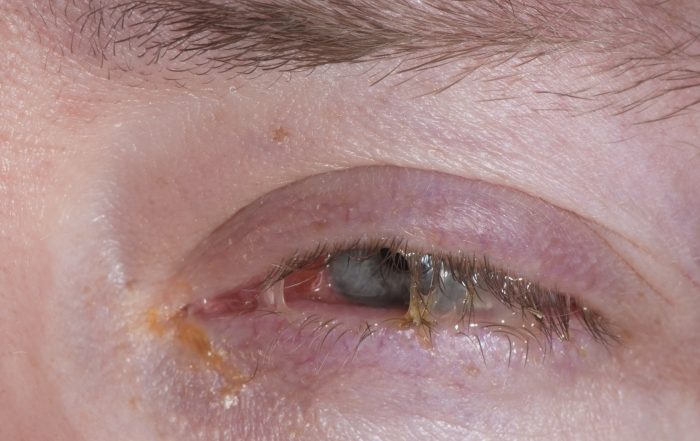
Blepharitis is a medical condition that causes inflammation, irritation, and redness of the eyelids. Those who have it can find it frustrating and uncomfortable, as it can cause itching, dryness, and sensitivity to light, among other things. Fortunately, there are treatments available, and one of the newest and most promising options is hypochlorous acid (HOCl) treatment. In this blog post, we’ll give you an overview of what blepharitis is, what causes it, and how HOCl treatment can help alleviate its symptoms. We’ll also explore the benefits of HOCl treatment and what makes it a safe and effective choice for those seeking relief from this condition. Whether you’re experiencing blepharitis for the first time or have been battling it for years, this post will give you the information you need to take control of your eye health.
What is Blepharitis?
Blepharitis is a chronic and persistent eye condition characterized by inflammation of the eyelids. Blepharitis can cause redness of the eyelid margins, swollen eyelids, crusting of the eyelashes, eye irritation, and a burning sensation. Bacterial or fungal infections are the cause of this condition. It is essential to maintain good eyelid hygiene by keeping the eyelids clean and avoid touching the eyes with dirty hands. Blepharitis can be managed with proper treatment, including effective HOCl product, warm compresses, eyelid scrubs, and prescription medication. If not treated adequately, blepharitis can cause vision impairments. It’s important to remember that you should always practice good hygiene to stop the spread of germs and infections. It’s important to remember that you should always practice good hygiene to stop the spread of germs and infections. In cases where symptoms persist despite home remedies, it is best to seek professional medical attention. Practicing good eye hygiene habits can go a long way in ensuring optimal eye health and providing relief from various eye-related conditions such as blepharitis.
Symptoms of Blepharitis
Blepharitis is a common eye condition that causes inflammation and irritation of the eyelids. It can lead to various symptoms such as redness, dryness, itching, burning, and stinging sensations. Additionally, flakes of skin may appear near the eyelashes, leading to irritation. The condition can also cause crusting on the eyelashes, which can affect overall vision if left untreated. Lack of proper eyelid and eyelash care can exacerbate the symptoms of blepharitis. To avoid or treat blepharitis, it is important to maintain good hygiene. For example, you should wash your eyelids regularly with mild soap and water. Blepharitis symptoms can also be relieved by putting warm compresses on the eyes. It is important to see an optometrist or ophthalmologist about blepharitis so that the cause can be found and the right treatment can be given. To keep your eyes healthy, you need to take care of your eyelids and eyelashes.
Also, it’s important to know that taking good care of your eyes can help stop and treat problems like blepharitis. One effective way to treat blepharitis is through the use of hypochlorous acid (HOCl), a natural and safe disinfectant that can help eliminate bacteria and reduce inflammation on the eyelids. HOCl can be used to clean and calm eyes that are red and itchy. Before using HOCl or any other eye care product, you should talk to an eye doctor or other health professional. In conclusion, taking good care of your eyes and going to the doctor right away when you need to can help you avoid and treat common eye problems like blepharitis, which can improve your vision and eye health in general.
Causes of Blepharitis
Eye care is an important aspect of overall health, and one condition that can cause discomfort and irritation is blepharitis. This condition develops when there is inflammation of the eyelids, which may be due to bacteria, allergies, or skin conditions. Symptoms may include redness, itching, and swelling of the eyelids. Fortunately, there are ways to relieve the discomfort associated with blepharitis. One option is to maintain the hygiene of the eyelids by regularly washing them with a gentle cleanser like VDOX® with Performance Stabilized HOCl. Warm compresses can also help because they reduce swelling and bring more blood to the area. By taking care of your eyes, like getting treatment for blepharitis, you can help keep your vision clear and improve your eyes’ overall health. Proper eye care is crucial to maintaining good eye health and preventing vision loss.
Besides the above-mentioned causes, other factors such as allergies, exposure to irritants, or certain medications might also trigger blepharitis. Therefore, it is crucial to maintain good eye hygiene habits, including washing hands regularly, avoiding rubbing eyes, and keeping contact lenses clean, to prevent the condition from progressing. Additionally, it is important to consult an eye doctor if any symptoms of blepharitis arise, to get safe and effective treatment options. With proper care and attention, one can safeguard their vision and maintain good eye health.
Treatments for Blepharitis
It is essential to take proper care of our eyes and seek medical attention when necessary. When it comes to treating blepharitis, topical antibiotics and warm compresses are usually the first line of treatment. However, in more severe cases, oral antibiotics or steroid drops may be required to alleviate the inflammation and reduce swelling. To help the body heal, it is also important to eat a well-balanced, healthy diet that is high in omega-3 fatty acids. Ultimately, it is important to prioritize eye health and seek professional help if any unusual symptoms or discomfort arise. Following these tips and practicing good eye care habits can go a long way toward maintaining healthy and functional eyesight.
The Benefits of HOCl Treatment for Blepharitis
Fortunately, there is a safe and effective treatment for this condition: hypochlorous acid (HOCl). HOCl is a naturally occurring molecule in the human body and is produced by white blood cells to fight off infections. VDOX® with Performance Stabilized HOCl effectively eliminates the microorganisms that cause blepharitis, reducing inflammation and promoting healing by breaking down lipid biofilm which clog the glands. Unlike some other treatments, VDOX® is safe to use with contact lenses and does not cause stinging or burning sensations. In conclusion, VDOX® is a safe and effective way to treat blepharitis. It relieves symptoms and helps keep your eyes healthy.
Additionally, maintaining clean and healthy eyesight is essential for enjoying life to the fullest. Cleansing with VDOX® on a regular basis can benefit those who suffer from blepharitis and the associated discomforts. Proper hygiene practices can help prevent the onset of various infections and ailments that can cause chronic discomfort and impact vision. Therefore, investing in proper eye care should not be taken lightly, and using advanced products like VDOX® can aid in the journey towards optimal eye health. By promoting good eye health practices daily, we can help reduce the risk of eye diseases and maintain clear vision throughout our lives.
To Conclude
In conclusion, if you’re one of the many individuals suffering from blepharitis, don’t despair. With the superior stability and efficacy of VDOX® with Performance Stabilized HOCl treatment, relief is closer than ever before. HOCl has been shown to eradicate microorganisms, reduce itch, increase oxygenation, reduce inflammation, and improve healing! From its ability to kill microorganisms and reduce inflammation to its effectiveness in treating chronic blepharitis and preventing recurrence, VDOX® is a safe and viable option for managing this common eye condition. Be sure to consult with your eye care professional to determine if VDOX® is right for you. With proper treatment and care, you can overcome blepharitis and enjoy clear, healthy eyes once again.
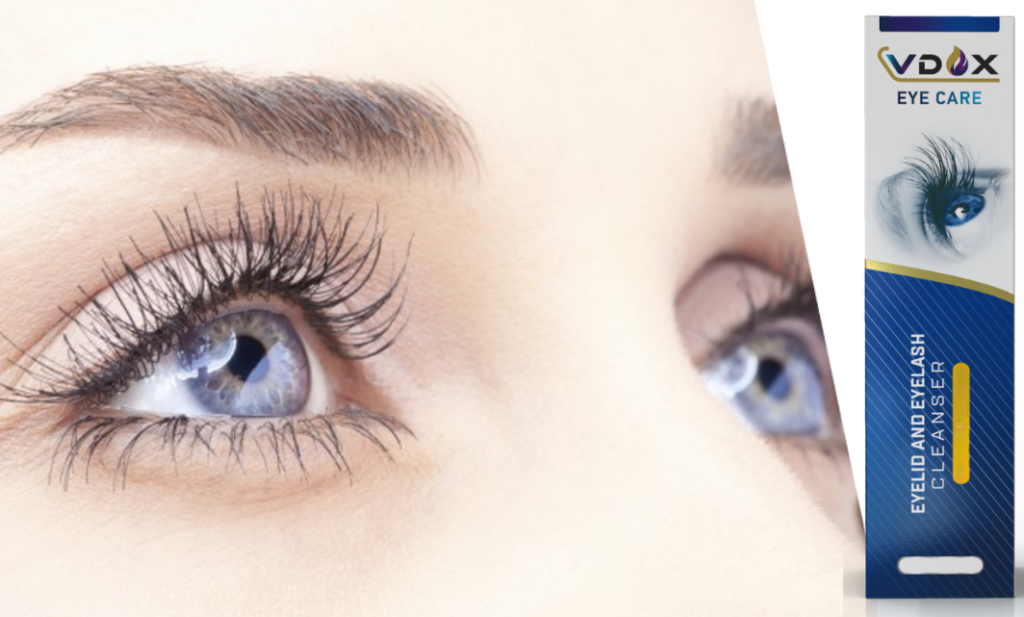
Hypochlorous acid (HOCl)
Hypochlorous acid (HOCl) is a naturally occurring substance produced by white blood cells as a first defense against microbial invaders. Its antimicrobial properties were recognized more than 100 years ago, when solutions containing HOCl were used to combat infections in the wounds of soldiers injured in WWI.
Only recently, however, has it been possible to manufacture a stable, pure version of HOCl. HOCl has potent antimicrobial properties. Laboratory studies show that it effectively kills the nymph form of the Demodex mites, as well as the Bacillus oleronius and Staphylococcus aureus bacteria that live on eyelids and that are found inside the Demodex gut. In addition, HOCl also neutralizes the inflammatory toxins released by both mites and bacteria.
Moreover, unlike tea tree oil, HOCl is completely non-toxic and non-irritating.
Remove any contacts or cosmetics and wash face before proceeding.
There’s no such thing as using VDOX® Eye Care. too frequently. For best results, use at least twice daily on both eyes — we suggest in the morning and before bed. Apply liberally and often as part of an effective eye care protocol.
VDOX® Eye Care can also be safely misted directly onto the eye and periocular region. A combination of both techniques will help to fully cleanse eyelids and eyelashes.
No rinse needed! Once applied, let the product air dry with eyes opened as normal.
VDOX® Eye Care can also be safely misted directly onto your contact lenses before and after use to ensure their safety and therefore the safety of our eyes.
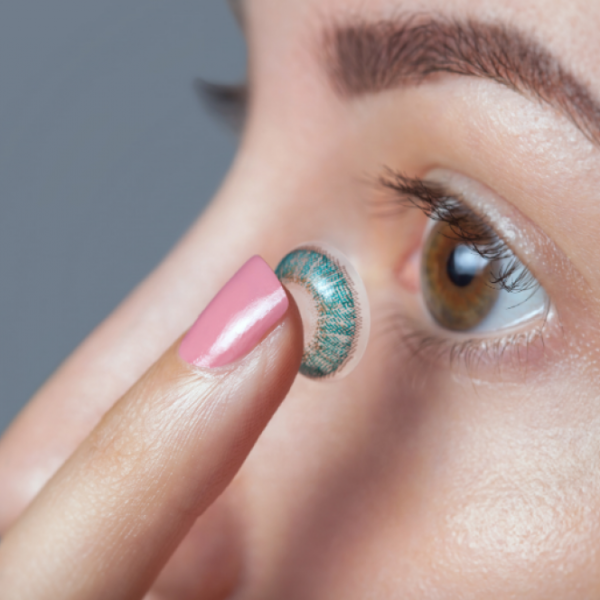
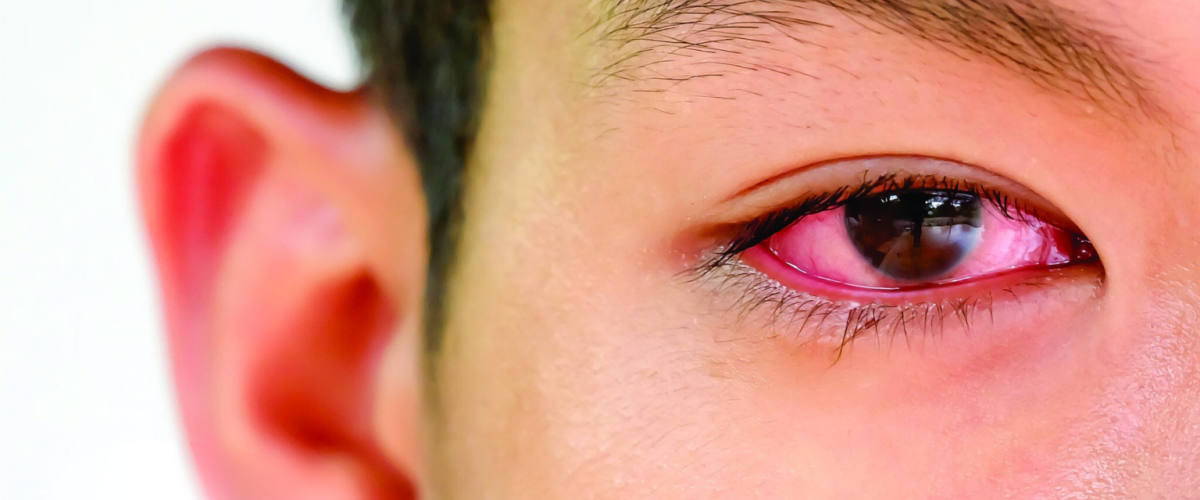
Maintaining good eye health is very important
and health insurance offers you quick access to specialists and diagnostic tests.
Most frequent pathologies affecting eye health
Among the most frequent are the following:


